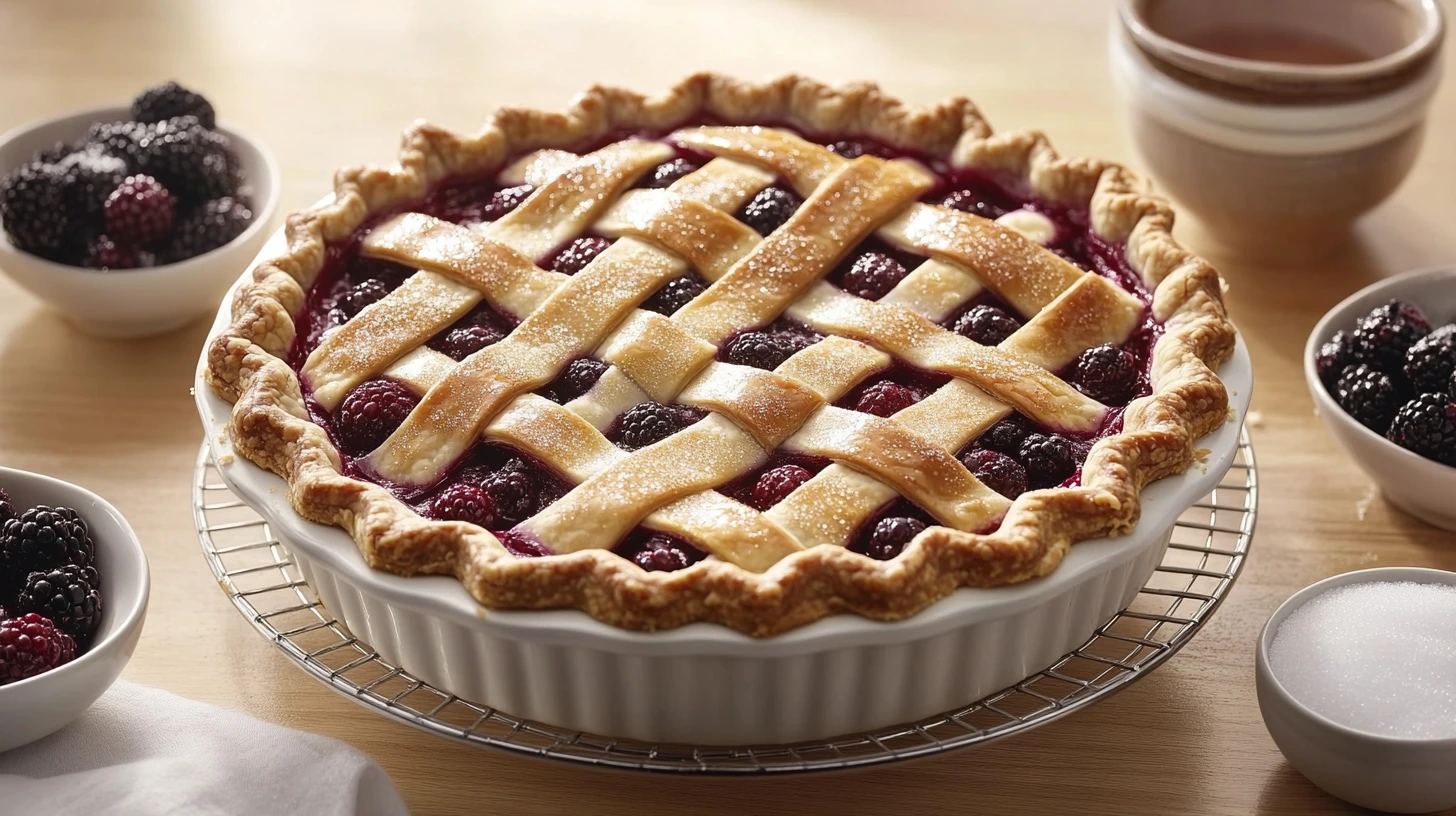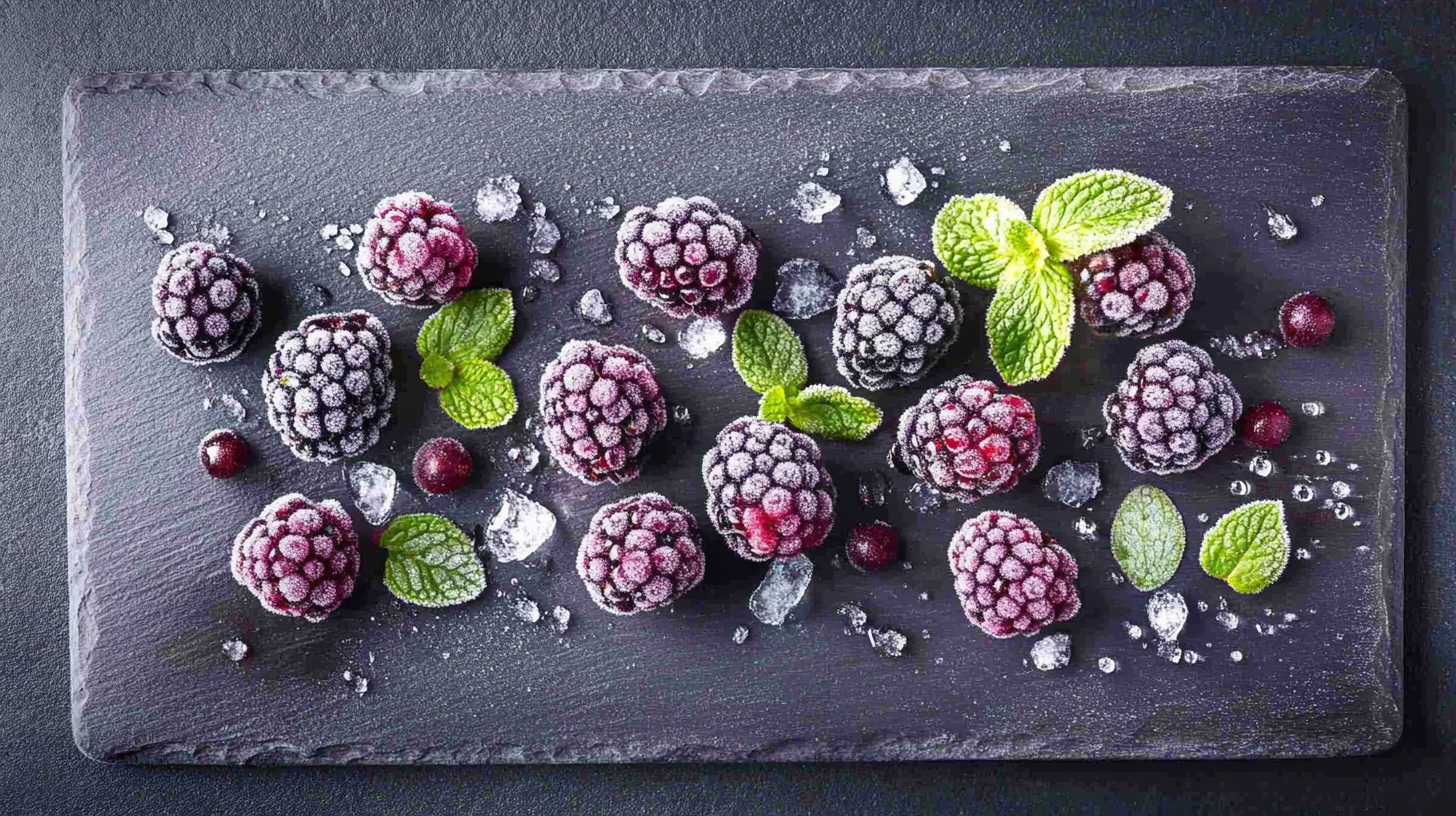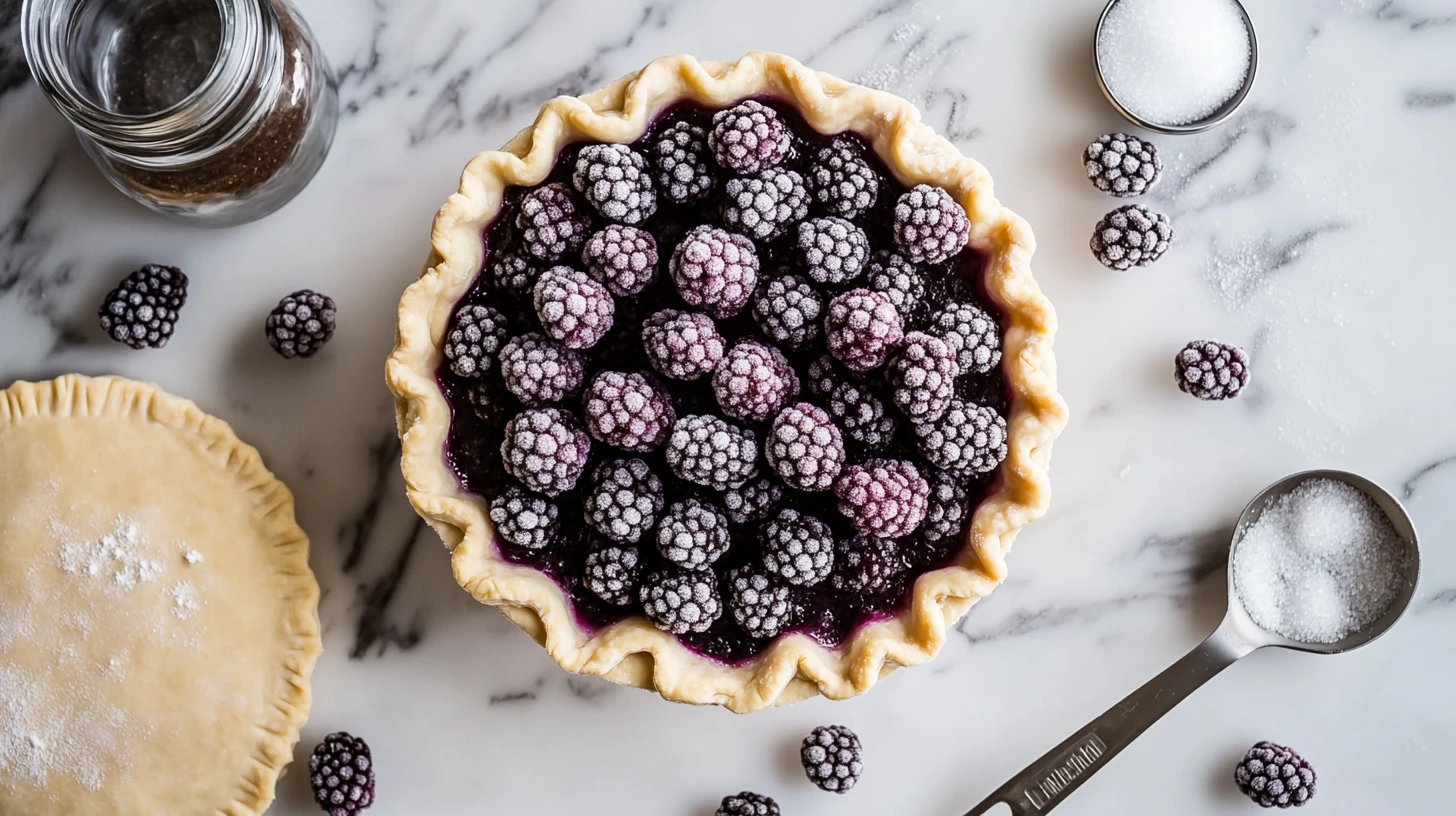Should I Thaw Frozen Blackberries Before Baking a Pie?

Introduction to Thawing Frozen Blackberries for Pie
One key decision bakers face when baking a blackberry pie is whether to thaw frozen blackberries before using them or bake them straight from the freezer. This seemingly simple choice can significantly affect the texture, consistency, and overall success of the pie.
Frozen blackberries offer convenience and accessibility, making them popular for pies, especially when fresh berries are out of season. However, thawing often depends on factors like texture preferences, pie structure, and the risk of a soggy filling. Understanding the pros and cons of both approaches will help you decide the best method for achieving a perfectly baked blackberry pie.
Understanding the Basics of Frozen Blackberries

Frozen blackberries are a convenient and versatile alternative to fresh berries, especially when out of season. However, their preparation and use in baking require understanding how freezing affects their texture and composition.
How Blackberries Are Frozen and Their Impact on Texture
Blackberries are typically frozen shortly after harvesting to lock in their freshness and preserve their nutrients. During the freezing process:
- Rapid Freezing: Modern freezing methods, like flash freezing, minimize cell wall damage by rapidly lowering the fruit’s temperature.
- Ice Crystal Formation: Even with rapid freezing, water inside the berries expands into ice crystals, which can rupture the cell walls.
The result is that frozen blackberries tend to be softer and more delicate than fresh ones, especially after thawing. This change in texture can affect their behavior in recipes, particularly in baking.
Why Frozen Blackberries Might Be Different from Fresh Ones
There are several key differences between fresh and frozen blackberries:
- Texture: Fresh blackberries have a firmer texture, while frozen ones become softer and more prone to breaking apart after thawing.
- Water Content: Frozen blackberries release more liquid when thawed, making pie fillings or baked goods runnier if not appropriately managed.
- Flavor: While the flavor is generally preserved during freezing, frozen berries can sometimes taste less vibrant compared to fresh ones due to the impact of freezing on natural sugars and acids.
The Benefits of Using Frozen Blackberries in Baking
Despite the differences, frozen blackberries offer several advantages:
- Accessibility: Frozen blackberries are available year-round, making them a reliable option even when fresh berries are out of season.
- Cost-Effectiveness: They are often more affordable than fresh blackberries, especially during the off-season.
- Convenience: Pre-washed and ready to use, frozen blackberries save time in preparation.
- Consistency: Frozen blackberries provide a consistent size and quality, making them easy to work with in recipes.
The Science Behind Thawing Frozen Fruit for Baking
Thawing frozen fruit before baking is a crucial step that impacts your pie’s final texture, consistency, and structural integrity. While thawing can provide certain benefits, it also comes with challenges that must be managed effectively.
Why Does Thawing Matter for Pies?
Thawing frozen fruit releases water that is trapped in the form of ice crystals. This water content affects how the fruit interacts with the other ingredients in your pie. Whether to thaw or not depends on your priorities for texture and the type of pie you’re baking.
Effect on Texture and Consistency
Thawed berries behave differently than fresh or frozen ones, directly impacting the pie filling:
- Softened Texture: Thawing breaks down the structural integrity of the blackberries, making them softer and more pliable. This can result in a smoother, more cohesive filling.
- Blended Appearance: Thawed blackberries tend to lose their distinct shape during mixing and baking, leading to a uniform but less visually defined filling.
- Even Flavor Distribution: The released juices from thawed berries blend well with sugar, spices, and thickeners, creating a consistent flavor throughout the filling.
The Risk of a Watery Pie-Filling
One of the main challenges of thawing frozen blackberries is managing the extra Liquid they release:
- Excess Liquid: Thawed blackberries release a significant amount of juice, which can make the filling overly runny if it is not adequately thickened.
- Soggy Crust: Liquid from the filling can seep into the crust during baking, resulting in a soggy bottom. This is especially problematic for pies that are not blind-baked.
- How to Counteract: To manage this risk, drain the berries after thawing and use thickeners such as cornstarch, tapioca starch, or flour in the filling to absorb excess moisture and ensure a firm texture.
The Case for Not Thawing Frozen Blackberries
While thawing frozen blackberries before baking has benefits, there are strong arguments for skipping this step. Baking with frozen fruit can often lead to better texture, structure, and crust integrity.
When You Should Skip Thawing
If you want to retain the shape and structure of the blackberries or avoid excess Liquid in your pie, baking directly with frozen berries is a good choice. This approach works particularly well for recipes where the appearance and texture of the berries matter or when preventing a soggy crust is a priority.
Advantages of Baking with Frozen Fruit
- Retaining Structure and Shape:
- Frozen blackberries retain better shape during baking than thawed ones, which can become mushy.
- This results in a pie filling with more distinct pieces of fruit, providing a visually appealing and textured experience.
- Preserving Flavor:
- Baking directly with frozen blackberries allows them to release their juices gradually as they bake. This helps concentrate the flavor in the pie filling without diluting it with excess Liquid.
Maintaining a Crisp Pie Crust
- Minimizing Liquid Seepage:
- Frozen berries release less liquid at the start of the baking process than thawed berries, reducing the risk of moisture soaking into the crust.
- This is especially important for double-crust or lattice-topped pies, where the bottom crust risks becoming soggy.
- Even Baking:
- As the frozen blackberries slowly heat up in the oven, the juices mix naturally with the sugar and thickeners in the filling, creating a consistent texture without requiring pre-draining.
The Pros and Cons of Thaw Frozen Blackberries for Pie
Deciding whether to thaw frozen blackberries before baking involves weighing the benefits and drawbacks of each approach. A balanced understanding of both can help you choose the best method for your pie.
Benefits of Thawing Before Baking
Thawing frozen blackberries can enhance the pie’s texture and flavor in several ways:
- Smoother Pie Filling:
- Thawed berries release juices, blending well with sugar, spices, and thickeners. This creates a more cohesive filling with a uniform flavor.
- Even Texture:
- Thawing the berries reduces the chances of having frozen spots inside the pie. The berries heat and cook evenly, ensuring a consistent texture throughout the filling.
- Improved Integration:
- Softened berries mix more easily with other filling ingredients, distributing flavors more easily and achieving a balanced filling.
Drawbacks of Thawing
Despite the benefits, thawing frozen blackberries also has potential downsides that need to be managed:
- Risk of a Soggy Pie:
- Thawed blackberries release a significant amount of Liquid, making the filling overly runny. The Liquid also soaks into the crust, compromising its crispness.
- Loss of Structure:
- Thawed berries are softer and more delicate, making them prone to breaking down during mixing and baking. This can lead to a pie filling with less defined fruit pieces.
- Extra Steps Required:
- Thawing adds an extra step to the baking process and may require draining the berries and adjusting the thickener to counteract excess Liquid.
How to Thaw Blackberries for Pie (If You Choose to Do So)
If you decide to thaw frozen blackberries for your pie, using a method that preserves their quality is essential. Proper thawing prevents excessive mushiness and helps manage the Liquid they release. Here are the best methods to ensure optimal results.
The Overnight Thawing Method
This is the slowest but most effective method for thawing blackberries while preserving their texture.
- Steps:
- Place the frozen blackberries in a colander or sieve over a bowl to catch any excess liquid.
- Cover the colander with plastic wrap or a lid to protect the berries from drying out.
- Refrigerate overnight, allowing the berries to thaw gradually.
- Why It Works:
- Gradual thawing minimizes damage to the berries’ cell structure, reducing mushiness.
- If desired, the Liquid collected in the bowl can be drained or incorporated into your pie filling.
Quick Thawing Methods
If you’re short on time, there are faster ways to thaw blackberries. These methods require more attention to avoid overheating or over-softening the berries.
Thawing Under Cold Water
- Steps:
- Place the frozen blackberries in a sealed plastic bag to prevent water absorption.
- Submerge the bag in a bowl of cold water.
- Change the water every 10–15 minutes to maintain a consistent temperature.
- Why It Works:
- Cold water speeds up thawing without introducing heat, which can break down the berries’ structure.
- This method is faster than overnight thawing but still gentle enough to preserve the berries’ quality.
Thawing in the Microwave
- Steps:
- Place the frozen blackberries in a microwave-safe dish.
- Use the defrost setting on your microwave, running it in short intervals (15–30 seconds).
- Gently stir the berries between intervals to ensure even thawing.
- Why It Works:
- Microwaving is the quickest option but requires careful monitoring to prevent the berries from cooking.
- It is best when you need thawed berries immediately and are prepared to handle slight texture loss.
Additional Tips
- Drain Excess Liquid: No matter the method, always drain the thawed berries to reduce the risk of a watery pie filling.
- Use the Liquid Wisely: If the juice from thawed berries is flavorful, consider incorporating it into your filling with an additional thickener to control consistency.
Tips for Baking the Perfect Pie with Frozen Blackberries

Baking a pie with frozen blackberries requires careful attention to detail to manage moisture and enhance flavor. These expert tips will help you create a delicious pie with a balanced filling and a perfectly baked crust.
Using Thickeners for a Better Pie-Filling
Frozen blackberries release more liquid during baking, making the filling runny if not adequately thickened. Adding the right thickener ensures a firm, sliceable texture.
- Common Thickeners:
- Cornstarch: A popular choice for its neutral flavor and ability to thicken quickly. Use about 1–2 tablespoons per cup of blackberries.
- Tapioca Starch: Provides a glossy finish and works well with high-moisture fruits like blackberries. Use 1–2 tablespoons per cup of fruit.
- Flour is a traditional thickener that works well but may result in a slightly cloudier filling. Use 2–3 tablespoons per cup of blackberries.
- Tips for Using Thickeners:
- Mix the thickener with sugar before adding it to the berries to ensure even distribution and prevent clumps.
- Allow the pie filling to bubble and cook thoroughly in the oven. This activates the thickener and ensures the filling sets as it cools.
Balancing Sweetness and Tartness
Frozen blackberries can be more tart than fresh ones, requiring adjustments to the sweetness levels in your recipe.
- Adjusting Sugar Levels:
- Add sugar gradually, tasting the mixture to achieve the desired balance. Start with ½ cup of sugar per cup of blackberries and adjust as needed.
- Consider using honey or maple syrup for a natural sweetener, but account for the added moisture.
- Enhancing Flavor:
- Add a pinch of salt to balance the sweetness and enhance the berries’ natural flavor.
- A squeeze of lemon juice or zest can brighten the filling and add depth to the tartness.
- Add complementary spices like cinnamon or nutmeg for a warm, aromatic touch.
FAQs About Thaw Frozen Blackberries for Pie
Here are answers to some of the most common questions about using frozen blackberries in pie, with expert advice to ensure your pie turns out perfectly.
Can I use frozen blackberries straight from the freezer?
You can use frozen blackberries directly from the freezer without thawing them first.
- Advantages:
- Baking with frozen berries helps retain their shape and structure.
- It prevents excess Liquid from seeping into the pie crust during preparation.
- Considerations:
- Add a thickener like cornstarch, tapioca, or flour to manage the extra moisture released as the berries bake.
- Bake the pie slightly longer to ensure the berries cook through and the filling thickens appropriately.
How do I prevent a soggy crust when using frozen blackberries?
A soggy crust is a common concern when baking with frozen fruit, but these tips can help:
- Pre-Bake the Crust: Blind bake the bottom crust before adding the filling. This creates a barrier that helps keep the crust crisp.
- Add a Barrier Layer: Sprinkle breadcrumbs, crushed cookies, or a thin layer of ground nuts on the crust before filling. These absorb excess Liquid.
- Use Thickener: Ensure the filling is thickened correctly to prevent Liquid from soaking into the crust.
- High Initial Heat: Start baking the pie at a higher temperature (400°F/200°C) for the first 15 minutes, then reduce the heat to finish baking. This helps set the crust quickly.
What if I accidentally thaw my blackberries too much?
If your blackberries have released too much Liquid after thawing, there are ways to salvage them:
- Drain Excess Liquid: Place the berries in a colander and drain the Liquid. Save the juice if you want to incorporate it into the pie filling.
- Adjust the Filling:
- Add an extra tablespoon or two of thickener to absorb the additional Liquid.
- Mix the juice with sugar and thicken it on the stovetop before adding it to the filling.
- Use as a Sauce: If the Liquid is flavorful, reduce it into syrup to drizzle over the finished pie or serve alongside.
Conclusion
When using frozen blackberries for pie, the decision to thaw or not depends on your baking goals. Each method has its benefits and challenges, and understanding these can help you achieve the perfect pie.
- Thawing Blackberries is ideal for smoother, more cohesive fillings, but it requires careful management of excess Liquid to avoid a soggy crust. Thawing is best when you want evenly blended flavors and a softer texture in your pie filling.
- Baking with Frozen Blackberries: Helps retain the berries’ structure, minimizes prep time, and reduces the risk of excess Liquid soaking into the crust. This approach is perfect for bakers who prioritize a crisp crust and visually distinct pieces of fruit.
Ultimately, both methods can produce a delicious blackberry pie. By adjusting your recipe with proper thickeners, managing moisture, and balancing flavors, you can create a pie that is both flavorful and beautifully baked—whether you choose to thaw the berries or not. Happy baking! 🍇🥧
